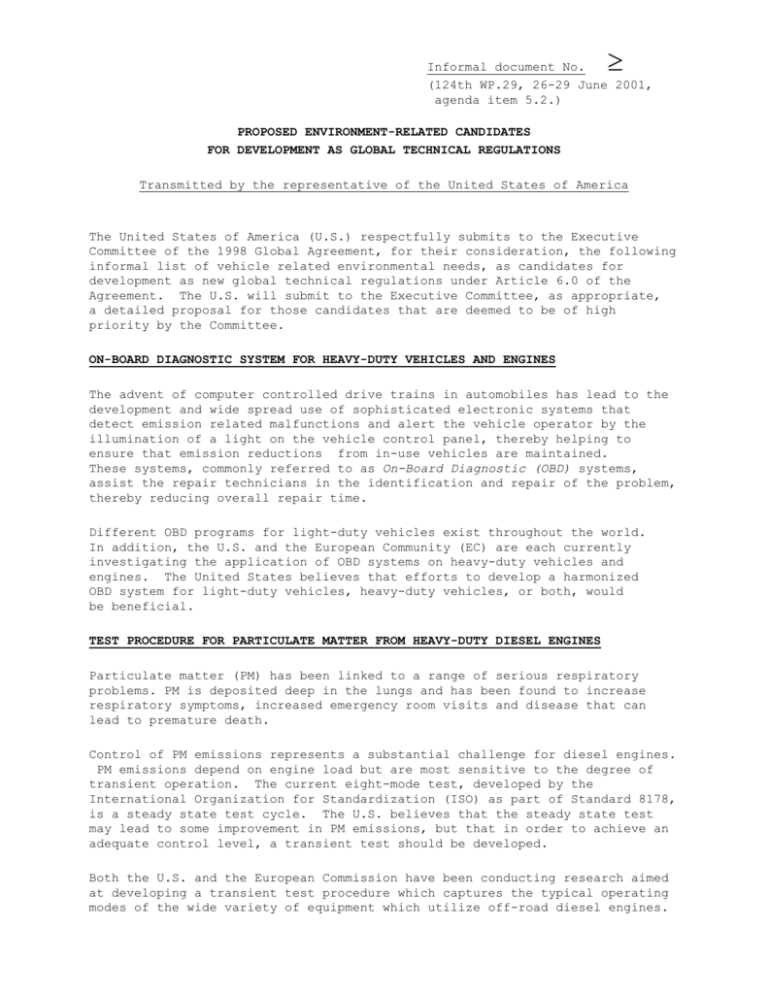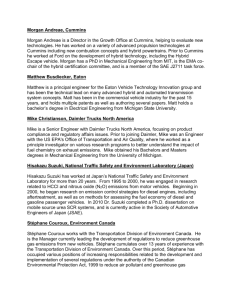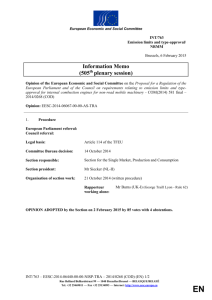Informal document No
advertisement

Informal document No. (124th WP.29, 26-29 June 2001, agenda item 5.2.) PROPOSED ENVIRONMENT-RELATED CANDIDATES FOR DEVELOPMENT AS GLOBAL TECHNICAL REGULATIONS Transmitted by the representative of the United States of America The United States of America (U.S.) respectfully submits to the Executive Committee of the 1998 Global Agreement, for their consideration, the following informal list of vehicle related environmental needs, as candidates for development as new global technical regulations under Article 6.0 of the Agreement. The U.S. will submit to the Executive Committee, as appropriate, a detailed proposal for those candidates that are deemed to be of high priority by the Committee. ON-BOARD DIAGNOSTIC SYSTEM FOR HEAVY-DUTY VEHICLES AND ENGINES The advent of computer controlled drive trains in automobiles has lead to the development and wide spread use of sophisticated electronic systems that detect emission related malfunctions and alert the vehicle operator by the illumination of a light on the vehicle control panel, thereby helping to ensure that emission reductions from in-use vehicles are maintained. These systems, commonly referred to as On-Board Diagnostic (OBD) systems, assist the repair technicians in the identification and repair of the problem, thereby reducing overall repair time. Different OBD programs for light-duty vehicles exist throughout the world. In addition, the U.S. and the European Community (EC) are each currently investigating the application of OBD systems on heavy-duty vehicles and engines. The United States believes that efforts to develop a harmonized OBD system for light-duty vehicles, heavy-duty vehicles, or both, would be beneficial. TEST PROCEDURE FOR PARTICULATE MATTER FROM HEAVY-DUTY DIESEL ENGINES Particulate matter (PM) has been linked to a range of serious respiratory problems. PM is deposited deep in the lungs and has been found to increase respiratory symptoms, increased emergency room visits and disease that can lead to premature death. Control of PM emissions represents a substantial challenge for diesel engines. PM emissions depend on engine load but are most sensitive to the degree of transient operation. The current eight-mode test, developed by the International Organization for Standardization (ISO) as part of Standard 8178, is a steady state test cycle. The U.S. believes that the steady state test may lead to some improvement in PM emissions, but that in order to achieve an adequate control level, a transient test should be developed. Both the U.S. and the European Commission have been conducting research aimed at developing a transient test procedure which captures the typical operating modes of the wide variety of equipment which utilize off-road diesel engines. - 2 IN-USE EMISSION COMPLIANCE TEST PROTOCOL FOR HEAVY-DUTY DIESEL POWERED VEHICLES Real-world health and environmental benefits from reductions of vehicle emissions can only be realized if emissions are controlled over the broad range of in-use vehicle speeds and load combinations. The nature of heavyduty engine production and use makes application of compliance programs difficult. One way to address these issues is to specify limits for each of the emission pollutants for all modes of in-use operation. The adoption of such a program would facilitate a test methodology that permits the sampling of emissions during normal vehicle operation outside a laboratory using portable emissions measurement technologies. The U.S. has developed and will apply beginning 2007, an in-use certification program for heavy-duty diesel engines. The not-to-exceed (NTE) program establishes an area under the torque curve of an engine where emissions must not exceed a specific value for any of the regulated pollutants, under any conditions associated with normal vehicle operation and real-world ambient environments. Various other methods of determining engine in-use engine performance are being explored by the technical community. Additional work should be carried out with regard to an acceptable test procedure. WORLDWIDE HEAVY-DUTY CERTIFICATION PROCEDURE (WHDC) In 1997 work was initiated by an ad-hoc work group, under the auspices of the WP.29/GRPE, to determine the feasibility of a harmonized engine test cycle for emission certification of heavy-duty engines. The intended test cycle would: . . . . . provide a uniform global basis for engine certification regarding exhaust emissions; be representative of world-wide real life heavy-duty engine operation; provide the highest potential for the control of real-life emissions; be applicable to future generation engine technology; and match emissions in relative terms for accurate ranking of different engines/technologies. The work carried out by the ad-hoc work group has reached a stage where feasibility has been confirmed and a decision should be taken as to whether the WHDC should be formally proposed for development as a global regulatory test procedure. The U.S. supports the formal development of the WHDC as a global regulatory test procedure, provided that (1) work be directed toward the validation of the candidate steady-state and transient cycles developed to date, (2) work include provisions for in-use testing of engine operation, and (3) the recommended certification procedure include "off-cycle" emission compliance certification that incorporates the not-to-exceed (NTE) emission limits approach. - 3 WORLDWIDE MOTORCYCLE CERTIFICATION PROCEDURE (WMTC) In 1999 work was initiated by an ad-hoc work group, under the auspices of the WP.29/GRPE, to determine the feasibility of a harmonized engine test cycle for emission certification of motorcycles. The intended test cycle would fulfil similar objectives to those stated for the WHDC. The work carried out by the ad-hoc work group has reached a stage where a decision should be taken as to whether the WMTC should be formally proposed for development as a global regulatory test procedure. The United States supports the formal development of the WMTC as a global regulatory test procedure with the recognition that outstanding technical issues need to be resolved. __________








